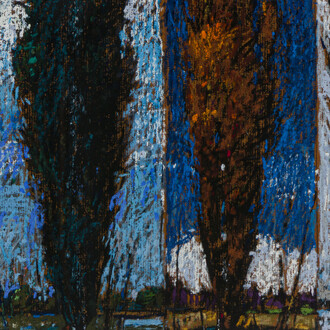Taliesin West fellows, Guy Michael Davis and Katie Parker of Future retrieval, present a biomimetic installation of ceramics, textile art, and works on paper informed by decades of inquiry into the history of decorative arts.
Founded in 2008, Future Retrieval aims to synthesize Davis and Parker’s creative practice with their critical research into the history of decorative arts. The exhibition, Underground world experience, features biomimetic textiles, handmade paper, and stoneware pots and wall tiles partially made during Davis and Parker’s residency at Taliesin West, legendary American architect Frank Lloyd Wright’s winter studio and home. The exhibition opens on the second floor of form & concept on September 26 from 5 to 7 PM.
Underground world experience is a feast of color and texture built of small units and an extension of Future Retrieval’s generative and iterative process. “The blank wall is a starved environment,” says Davis. Future Retrieval feeds these voids with objects that are thoughtfully designed, meticulously made, and aesthetically arresting. In 2011, the artists’ participation in an exhibition that invited local artists in Cincinnati, OH, to create work in response to the permanent collection at the Taft Museum of Art led to other projects where the creation of works was informed by research and the study of museum and library collections. Mindful of the institutional spaces and histories their works were in dialogue with, they conceptualized exhibitions that carried their distinct presence while integrating with those specific environments. Of their process, Parker states, “We work in a continuum, where projects bleed from one to the next as we build our personal library/lexicon of images and objects through permissions and access to archives and collections.”
Underground world experience represents the most recent iteration of Davis and Parker’s research. Their digital archive of images sourced from illustrated books in the Lloyd Library and Museum in Cincinnati continues to grow and includes the endpapers of rare books on mycology from the Lloyd Library that serve as a visual reference for the hand-cut paper assembled to simulate marbled paper featured in this exhibition. The holes and swirls within these hand-cut paper pieces provide the silhouettes and patterns for the biomorphic ceramic sculptures (that resemble sea creatures or the East Asian scholar’s rocks) and the hand-knotted rug, which generated the color scheme and patterns for the large pot that sits on the rug. Gallery director Carina Evangelista notes, “If the art of marbling paper known as ebru, Turkish for ‘the art of the clouds,’ is about the blossoming of patterns through the mastery of floating ink in water, Future Retrieval extracted multiple iterations from the water baths that produced marbled endpapers centuries ago—from paper to textile to stoneware in the earthy colors and lush flora of the Sonoran desert.”
In their recent research at Taliesin West, Future Retrieval has inverted Frank Lloyd Wright’s philosophy of integrating objects into the landscape by integrating the landscape into their objects. Hand-formed stoneware pots and wall tiles feature the sunlit hues of the Southwest, reflect the stone and sand of its terrain, and evoke the desert daisies that populate the arid wilderness of Taliesin West. The chromatically saturated wool rug made of hundreds of individual hand knots gives physical form to the abstract idea of a microscopic primordial soup that once occupied the ocean that was the Southwest tens of millions of years ago, and from which bacteria, fish, reptiles, mammals, and eventually intelligent life evolved.
Through their works’ ecological motifs, Future Retrieval indirectly asks us to look at nature and how our built environment integrates with it. Are we building a future? Or are we building more of the present—more industrialization, more extraction, more waste, which ultimately promises no future. Future Retrieval’s response to this depressing question is one of hope: to meet the functional and aesthetic needs of today while securing the future against calamity, we must reintegrate utility, beauty, mindful consumption, and thoughtful design back into our objects, lived spaces, communities, and society at large. Perhaps thus we can regain possession of our future.













